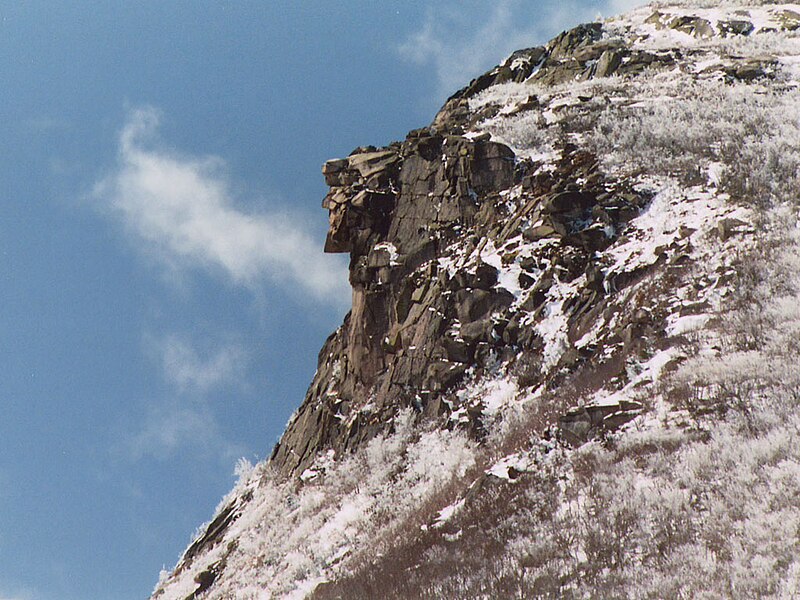 |
| This photo was taken 7 days before the formation's collapse. |
The Old Man of the Mountains Collapses, 2003
The Old Man of the Mountains, also known as The Great Stone Face or The Profile, was a natural rock formation in the White Mountains of New Hampshire. It had been formed by eons ago by glacial action and consisted of a series of five cliff ledges. When viewed from a certain perspective, the ledges took on the aspect of a face.A surveyors working in the mountains in 1805 were the first white men to have see the unusual formation. They thought it looked like Thomas Jefferson. Daniel Webster helped ensure the fame of the Old Man. Comparing the sight to the signs craftsmen hang out advertising their craft, Webster said, "...up in the mountains of New Hampshire, God Almighty hung out a sign to show that there He makes men." In 1832, Nathaniel Hawthorne brought further fame to the wonder with his story "The Great Stone Face," based on the Old Man of the Mountains. In 1945, the Old Man became the official State Emblem for New Hampshire.
 |
| The reverse of the New Hampshire quarter. |
A state highway worker named Niels Nielson became the unofficial caretaker for the natural monument in 1965, and the state made it official in 1987. Every year he would climb to the top of the Old Man's head, test and repaint the turnbuckles, and seal cracks in the stone. Dangling from above in a bos'n's chair, he washed the face to prevent erosion from acid rain. He used a garden hoe to clean out the ear. Nielson retired from the strenuous job in 1991, and was succeeded by his son David.
Sometime between midnight and 2:00 am on May 3, 2003, the Old Man of the Mountains finally collapsed. Mourners left flowers at the foot of the mountain.
 |
| A scene from the film. |
Raja Harishchandra Released, 1913
Raja Harishchandra was the first feature-length film made in India. It was a silent film directed and produced by Dadasaheb Phalke, and marked the beginning of the Indian film industry.The film tells the story of Harishchandra, a Hindu king known for his virtuous and honorable life. In order to fulfill a promise to the sage Vishwamitra he sacrifices his kingdom, his wife, and his children. Ultimately, the Gods are so pleased with him that the restore him to his previous status and heap additional blessings on him.
Making the film was not without its challenges. Working in films was considered a taboo, so actors and production crew told their friends and relatives they were working in the "Harishchandra Factory." Phalke's wife, working alone, cooked meals for the entire cast and crew, some 500 people. She also washed clothes and costumes, and helped in other ways. The film is notable in that it is comprised of an all-male cast -- even the female parts were played by male actors.
The film was about 40 minutes long and was a success when it was released. Additional prints had to be made so that it could be viewed in rural areas. Unfortunately, only the first and last reels have been preserved.
.jpg/450px-Jerzy_Kosinski_(1973).jpg) |
| Kosinski in 1973. Photo by Rob Mieremet/Anefo. |
Jerzy Kosinski's Death, 1991
Novelist Jerzy Kosinski was born Jozef Lewinkopf in Lodz, Poland, in 1933. He was Jewish, and he and his family survived the Holocaust due to the support and protection of local residents. At this time he took on the false identity "Jerzy Kosinski." After the war he remained in Poland initially, earning two graduate degrees (in history and sociology) and teaching at the Polish Academy of Sciences. He also served in the Polish Army.In 1957, Kosinski came to the United States. In order to emigrate, he forged letters from a fictitious corporation that was supposed to be sponsoring him. He also forged letters from prominent communist leaders guaranteeing his return to Poland. Kosinski's writing career started early.
In the United States, Kosinski completed a degree at Columbia University, and then received grants from the Guggenheim Fellowship, the Ford Foundation, and the American Academy. In addition to his writing, he lectured at Yale, Princeton, Davenport University, and Wesleyan University.
Kosinski's first three novels, The Painted Bird, Steps, and Being There were all immensely successful. The Painted Bird is about the experiences of a young homeless boy in Eastern Europe during World War II, and depicts extremely abusive treatment from the people he encounters. The book was banned in Poland until 1989. Although Kosinski stresses that it is fiction, it has not been well-received by the villagers who sheltered him during the war.
Being There is the story of a simple gardener who achieves fame and fortune when his simple utterances are taken as visionary comments. The novel was made into an award-winning movie starring Peter Sellers in 1979.
In August of 1969, Kosinski was invited to dinner at the home of Roman Polanski and Sharon Tate. Flying from Paris to Los Angeles, his luggage was sent to New York. Kosinski spent the night in New York City and missed the dinner party. That night, Sharon Tate and the guests were killed by the Charlie Manson and his followers.
Kosinski committed suicide on May 3, 1991. After taking a fatal dose of barbiturates with alcohol, he placed a plastic bag around his head and taped it shut. He left a note reading, "I am going to put myself to sleep now for a bit longer than usual. Call it Eternity."
No comments:
Post a Comment